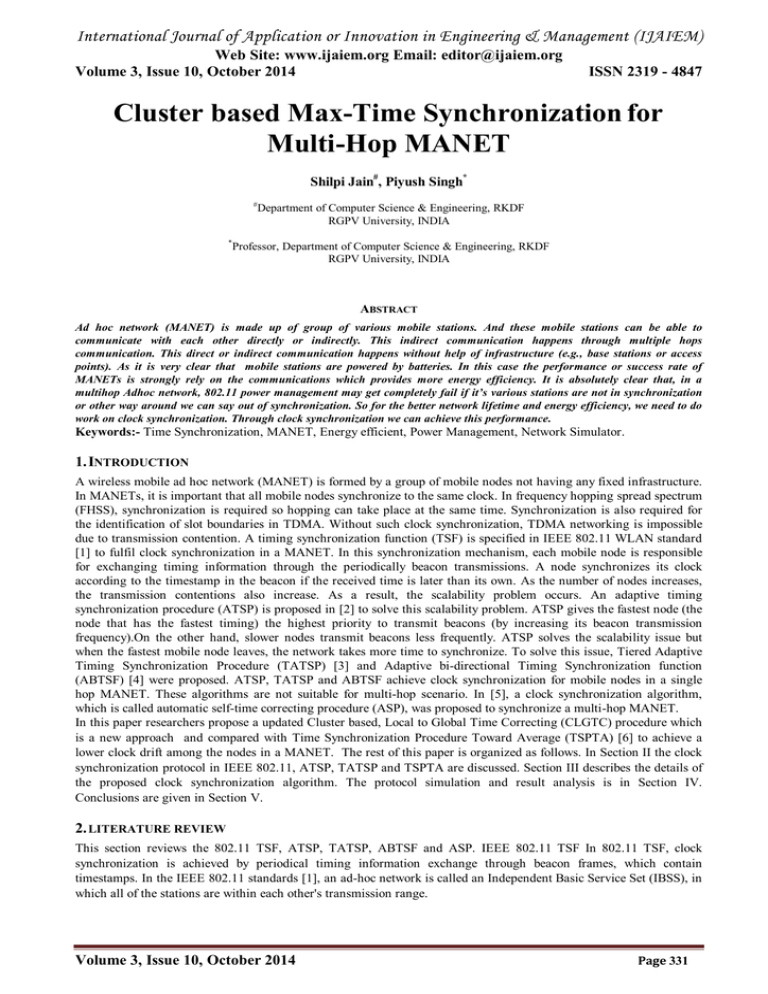Cluster based Max-Time Synchronization for Web Site: www.ijaiem.org Email:
advertisement

International Journal of Application or Innovation in Engineering & Management (IJAIEM) Web Site: www.ijaiem.org Email: editor@ijaiem.org Volume 3, Issue 10, October 2014 ISSN 2319 - 4847 Cluster based Max-Time Synchronization for Multi-Hop MANET Shilpi Jain#, Piyush Singh* # * Department of Computer Science & Engineering, RKDF RGPV University, INDIA Professor, Department of Computer Science & Engineering, RKDF RGPV University, INDIA ABSTRACT Ad hoc network (MANET) is made up of group of various mobile stations. And these mobile stations can be able to communicate with each other directly or indirectly. This indirect communication happens through multiple hops communication. This direct or indirect communication happens without help of infrastructure (e.g., base stations or access points). As it is very clear that mobile stations are powered by batteries. In this case the performance or success rate of MANETs is strongly rely on the communications which provides more energy efficiency. It is absolutely clear that, in a multihop Adhoc network, 802.11 power management may get completely fail if it’s various stations are not in synchronization or other way around we can say out of synchronization. So for the better network lifetime and energy efficiency, we need to do work on clock synchronization. Through clock synchronization we can achieve this performance. Keywords:- Time Synchronization, MANET, Energy efficient, Power Management, Network Simulator. 1. INTRODUCTION A wireless mobile ad hoc network (MANET) is formed by a group of mobile nodes not having any fixed infrastructure. In MANETs, it is important that all mobile nodes synchronize to the same clock. In frequency hopping spread spectrum (FHSS), synchronization is required so hopping can take place at the same time. Synchronization is also required for the identification of slot boundaries in TDMA. Without such clock synchronization, TDMA networking is impossible due to transmission contention. A timing synchronization function (TSF) is specified in IEEE 802.11 WLAN standard [1] to fulfil clock synchronization in a MANET. In this synchronization mechanism, each mobile node is responsible for exchanging timing information through the periodically beacon transmissions. A node synchronizes its clock according to the timestamp in the beacon if the received time is later than its own. As the number of nodes increases, the transmission contentions also increase. As a result, the scalability problem occurs. An adaptive timing synchronization procedure (ATSP) is proposed in [2] to solve this scalability problem. ATSP gives the fastest node (the node that has the fastest timing) the highest priority to transmit beacons (by increasing its beacon transmission frequency).On the other hand, slower nodes transmit beacons less frequently. ATSP solves the scalability issue but when the fastest mobile node leaves, the network takes more time to synchronize. To solve this issue, Tiered Adaptive Timing Synchronization Procedure (TATSP) [3] and Adaptive bi-directional Timing Synchronization function (ABTSF) [4] were proposed. ATSP, TATSP and ABTSF achieve clock synchronization for mobile nodes in a single hop MANET. These algorithms are not suitable for multi-hop scenario. In [5], a clock synchronization algorithm, which is called automatic self-time correcting procedure (ASP), was proposed to synchronize a multi-hop MANET. In this paper researchers propose a updated Cluster based, Local to Global Time Correcting (CLGTC) procedure which is a new approach and compared with Time Synchronization Procedure Toward Average (TSPTA) [6] to achieve a lower clock drift among the nodes in a MANET. The rest of this paper is organized as follows. In Section II the clock synchronization protocol in IEEE 802.11, ATSP, TATSP and TSPTA are discussed. Section III describes the details of the proposed clock synchronization algorithm. The protocol simulation and result analysis is in Section IV. Conclusions are given in Section V. 2. LITERATURE REVIEW This section reviews the 802.11 TSF, ATSP, TATSP, ABTSF and ASP. IEEE 802.11 TSF In 802.11 TSF, clock synchronization is achieved by periodical timing information exchange through beacon frames, which contain timestamps. In the IEEE 802.11 standards [1], an ad-hoc network is called an Independent Basic Service Set (IBSS), in which all of the stations are within each other's transmission range. Volume 3, Issue 10, October 2014 Page 331 International Journal of Application or Innovation in Engineering & Management (IJAIEM) Web Site: www.ijaiem.org Email: editor@ijaiem.org Volume 3, Issue 10, October 2014 ISSN 2319 - 4847 Figure 1: Beacon generation window [2]. According to the IEEE 802.11 specifications [1], each station maintains a TSF timer (clock) of the order of microseconds. Clock or timing synchronization is achieved by nodes periodically exchanging timing information through beacon frames. Each node in an IBSS shall adopt the timing received from any beacon that has a TSF time value (the timestamp) later than its own TSF timer. All nodes in the IBSS adopt a common value, a Beacon Period, which defines the length of beacon intervals or periods. This value, established by the node that initiates the IBSS, defines a series of Target Beacon Transmission Times (TBTTs) exactly a Beacon Period time units apart. Time zero is defined to be a TBTT. Beacon generation in an IBSS is distributed; all nodes in the IBSS participate in the process as follows. ATSP ATSP was proposed in [2] to solve the scalability problem. Here in ATSP the fastest station competes for beacon transmission every beacon period and other stations compete occasionally. In ATSP each node is assigned an integer I(i) that determines how often each node shall participate in beacon contention. Each node contends for beacon transmission once every I(i) beacon periods. Therefore smaller the value of I, higher the node chances of beacon transmission. The only problem arises with ATSP when the fastest node leaves the IBSS. Then the network takes more time to synchronize. TATSP TATSP is proposed in [3]. TATSP dynamically classifies the stations into three tiers according to the clock speed. The stations in tier 1 compete for beacon transmission in every beacon period and the stations in tier 2 will compete once in a while and the stations in tier 3 rarely compete. TATSF is compatible with 802.11 TSF. TSPTA For energy-efficient communication, time synchronization protocols play a basic and important role because all nodes have to have the same time information. We have proposed a time synchronization algorithm that performs well in dense and multi-hop networks [6]. The TSPTA algorithm uses the time information through the received beacon signal instead of particular nodes information. In this method, a node performs Local Averaging, which is a simple procedure and features decentralized processing. When a node does not receive the time information in the beacon transmission interval, it executes Self-Correcting. We validated the method with simulation results, which show that time synchronization is performed effectively with short process time. 3. PROPOSED CLOCK SYNCHRONIZATION ALGORITHM 3.1 Synchronization Procedure The main concept of the proposed work is based on maximum clock time stamp of the node. Whenever communication between two nodes or among any number of nodes want get start before that those need to make route among them. While nodes are sending beacon message to each other for the route discovery, what researchers are doing, they simple passing the time stamp of their time. Afterward each and every nodes get that time stamp and this process goes on. After getting response from all the nodes, each node will find the maximum value of time stamp from each node. After the completion of the beacon interval each node will update it’s time stamp with difference value. 3.2 Algorithm for Synchronization This section deals with step by step execution steps of the proposed CMTSMH method as follows: Figure 2: CMTSMH algorithm Volume 3, Issue 10, October 2014 Page 332 International Journal of Application or Innovation in Engineering & Management (IJAIEM) Web Site: www.ijaiem.org Email: editor@ijaiem.org Volume 3, Issue 10, October 2014 ISSN 2319 - 4847 4. SIMULATION AND RESULTS We have used NS-2 (Network Simulator) [7] for simulating various aspects of clock synchronization. The simulation area of the whole MANET is 800 m×600 m. The transmission radius of a station is 250 m. We assume that the clock difference between any two stations ranges is 0 at initial point of time. Various properties with their values are shown in following table: Table 1: Simulation Parameters Property set val(chan) set val(prop) set val(netif) set val(mac) set val(ifq) set val(ll) set val(ant) set val(ifqlen) set val(nn) set val(rp) set val(x) set val(y) set val(stop) Values Channel/WirelessChannel Propagation/TwoRayGround Phy/WirelessPhy Mac/802_11 Queue/DropTail/PriQueue LL Antenna/OmniAntenna 50 20 MAODV 800 600 100 Figure 2: Shows Structures of all 20 nodes and how those are attached with each other. Figure 3 show the ultimate result for which researchers have done all exercise. This result shows the clear cut picture of the proposed work over base paper work. Volume 3, Issue 10, October 2014 Page 333 International Journal of Application or Innovation in Engineering & Management (IJAIEM) Web Site: www.ijaiem.org Email: editor@ijaiem.org Volume 3, Issue 10, October 2014 ISSN 2319 - 4847 Figure 3: Comparison between Proposed with Base Work 5. CONCLUSIONS CMTSMH in a multi-hop MANET is proposed. In this algorithm clock drift is simplified compared to TSPTA, which improves clock synchronization. A new parameter average clock drift introduced to calculate the performance. Simulation results show that an improvement is achieved in the average of clock drift over TSPTA. CMTSMH also reduces the computational requirement. References [1] IEEE Std 802.11. Wireless LAN Medium Access Control (MAC) and Physical Layer (PHY) specification,1999 edition. [2] Lifei Huang, Ten-Hwang Lai, "On the Scalability of IEEE 802.11 Ad Hoc Networks," in Proceedings of MobiHoc 2002, pp. 173-182. [3] T. H. Lai and D. Zhou, "Efficient and scalable IEEE 802.11 Ad-Hoc Mode Timing synchronization Function," in Proceedings of the 17th International Conference on Advanced Information Networking and Applications, Mar. 2003, pp. 318–323. [4] Dong Zhou, Ten-Hwang Lai, "Analysis and Implementation of Scalable Clock Synchronization Protocols in IEEE 802.11 Ad Hoc Networks," the first IEEE international conference on Mobile and Sensor Systems, Oct. 2004. [5] Jang-Ping Sheu, Chih-Min Chao, Ching-Wen Sun, "A Clock Synchronization Algorithm for Multi-Hop Wireless Ad Hoc Networks," pp. 574-581, ICDCS 2004. [6] Yun-Jae Shin and Jung-Ryun Lee, "Time Synchronization Protocol in Ad hoc network," IEEE-ICOIN 2013. [7] The Network Simulator. ns-2. http://www.isi.edu/nsnam/ns/ Volume 3, Issue 10, October 2014 Page 334



